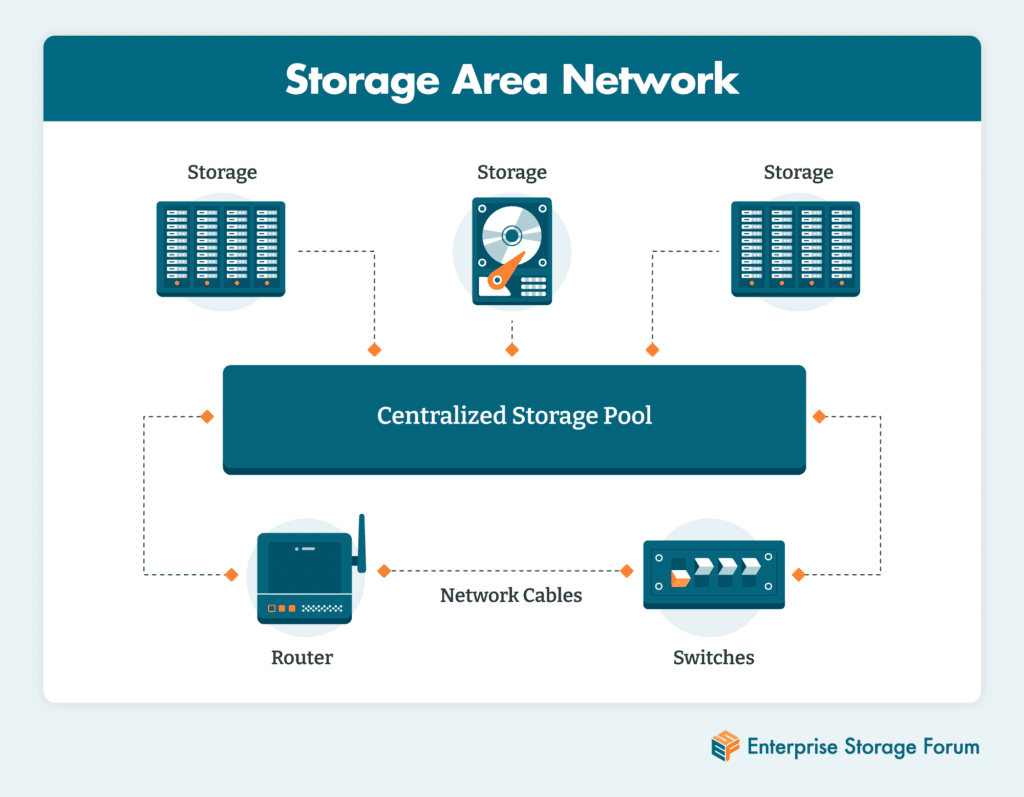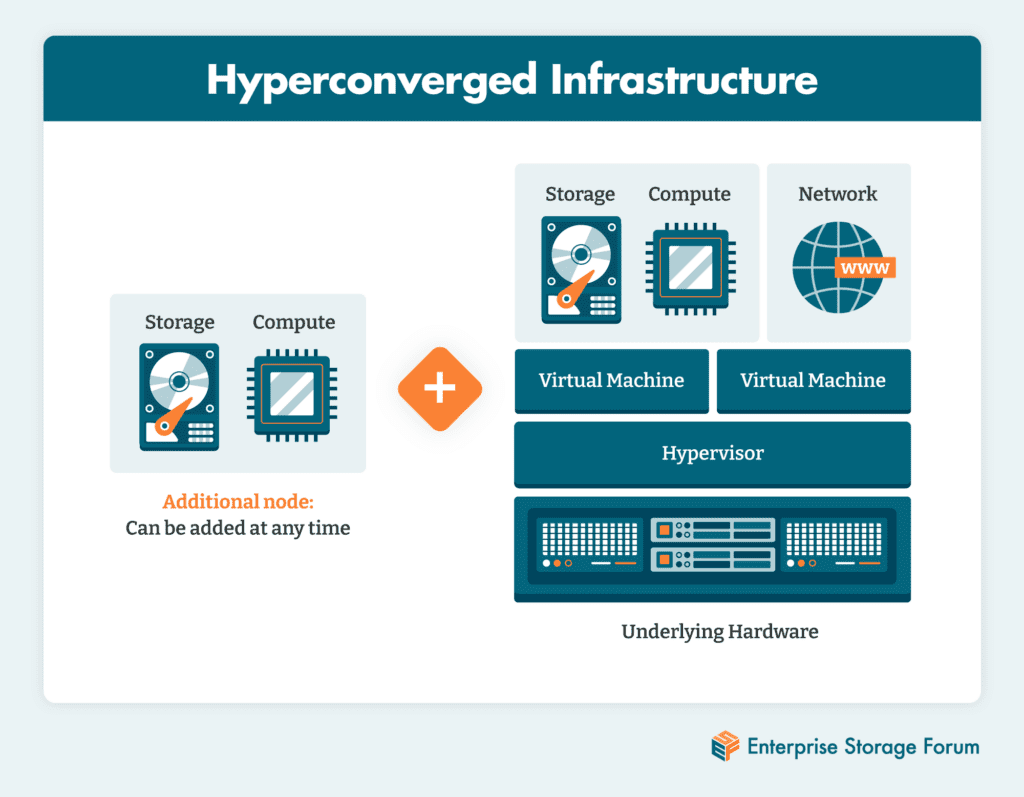Storage area networks and hyperconverged infrastructures are two different approaches to managing the high-volume and rapid-access data storage needs of enterprises. A storage area network, or SAN, is an entire network that pools block-level storage from multiple devices so the data can be accessed as though it is stored on a single device. Hyperconverged infrastructure is a solution for storage, compute, and networking that allows teams to move past a restrictive hardware-based infrastructure toward a more flexible software-based infrastructure. SAN and HCI serve different use cases within data storage infrastructures. This guide covers their differences and similarities to help you decide which is a better fit for your business.
How Do SANS and HCI Work?
Both storage area networks and hyperconverged infrastructure help businesses manage their storage resources with greater flexibility. However, they accomplish that differently.
How a Storage Area Network Works
A SAN is designed to connect storage resources within a specific organization, data center, office, or other environment. In a SAN, all storage devices, switches, routers, and other networking technology are connected on a single network fabric. Protocols like Ethernet and Fibre Channel enable the network nodes, or connection points like switches, to communicate.
Host bus adapters (HBAs) connect host servers to the SAN by interfacing with the storage devices or network devices on the network.
The purpose of this is pooling storage resources for concurrent access. By connecting to the network, you can access servers, flash arrays, and other storage devices on that network, regardless of their physical location.
SANs are beneficial for large organizations that need to connect storage resources—particularly enterprises with multiple critical applications. They’re also a good choice for experienced storage teams that want to customize a storage network to their organization’s specific needs.
How Hyperconverged Infrastructure Works
In a hyperconverged infrastructure, storage, compute, and networking resources are combined in one product. Some newer HCI products allow teams to scale the amount of storage they need independently from compute and networking and vice versa, saving businesses money when they don’t need as much of one resource.
The HCI platform will include both software and hardware components. This can be either commodity hardware (like x86 servers) or a vendor’s specific hardware. All HCI components are virtualized—abstracted from the underlying compute, network, and storage hardware—and managed by a hypervisor, or software that runs virtual machines.
Typically, everything in an HCI platform comes from one vendor rather than cobbling together different network components. This gives the advantage of ease of deployment and use—generally speaking, everything works together. However, traditional hyperconverged infrastructures are prone to vendor lock-in. Some of the top products in the market have shifted toward a more open architecture that supports multiple hypervisors, servers, or other storage products—check with vendors before you take the plunge.
HCI is a little different from a typical storage solution because it also combines storage with computing and networking resources.
Main Differences between SANs and HCI
SANs and HCI often differ in customizability, ease of management, and workload support. Many of these differences are generalizations, and nuances often depend on the specific product or platform.
Customizability
SANs sometimes include network and storage components from different vendors, while HCI is often a package product. This doesn’t necessarily mean you can’t use commodity hardware in a vendor-packed HCI. Just be sure to communicate with the vendor and know whether you’ll be locked into specific hardware and software.
Along the same lines, SANs are generally more customizable than hyperconverged environments. If you have an experienced storage team and want to design your own network, SAN is probably a better choice than HCI.
Ease of deployment and management
Overall, SANs tend to be more complex, while HCI is usually easier to manage and deploy. Implementing a complex storage area network requires networking expertise, and if the switches and other hardware come from different vendors, the integration process could take even more time.
Conversely, because HCI platforms are often provided as an entire stack by the vendor, they’re designed to work together. Some HCI services may also include implementation assistance from the vendor.
Application support
SANs can support multiple applications, including virtualized and non-virtualized workloads. In contrast, non-virtual machine applications typically won’t run in a hyperconverged environment because HCI is a virtualization technology. If some of your critical applications aren’t running on VMs, an HCI won’t support them.
Main Similarities Between SAN and HCI
While SANs and hyperconverged infrastructures are different approaches to data storage, they have a couple of similarities, including a focus on combining storage and networking and the ability to serve organizations of multiple sizes.
Dual focus
Both SANs and hyperconverged infrastructures combine data storage and networking to improve efficiency within IT architectures. HCI also combines compute resources with storage and networking components.
Support businesses of multiple sizes
Generally speaking, SAN and HCI can be implemented in both small and large organizations. However, the specific design of the storage network or hyperconverged environment will depend on business and storage team size, as well as personnel expertise.
When to Use SAN and HCI
The use cases below help outline some of the reasons your business might want to deploy either a SAN or an HCI. Also, some storage networks and hyperconverged infrastructures can coexist in an organization’s data centers depending on deployment. Larger enterprises may decide they need both for different use cases.
Use cases for storage area networks
SANs can support a variety of critical workloads, like databases and CRMs, but they don’t have to be restricted to such applications. However, if your business needs a high-performing storage network, consider developing your own SAN. The following are a few examples of ideal SAN use cases.
High-performance databases
Storage area networks are one of the best solutions to support critical business databases. These particular storage solutions need significant bandwidth to handle rapid and frequent queries, and SANs with the appropriate networking setup can provide that.
Backup
SANs support significant backup efforts—enterprise storage teams are responsible for protecting large volumes of data, and SANs allow them to back up those volumes on a regular basis. Teams have the option to back up the entire network rather than individual devices or arrays, which saves time and reduces complexity.
Virtualization
While both SANs and HCI support virtual environments—and HCI largely relies on virtualization—storage networks particularly shine in supporting high-performance computing environments, including virtual ones. SANs typically have high input and output rates, which enables them to transfer data faster.
Use cases for hyperconverged infrastructure
HCI is particularly beneficial for virtual desktop infrastructure (VDI), as well as linear storage scaling and SMB storage infrastructures.
Virtual desktop infrastructure
Virtual desktop infrastructures allow teams to access virtual machines from remote locations. HCI supports VDI well because it takes less time to deploy in a hyperconverged infrastructure and all components of the infrastructure are already compatible with each other. Additionally, when set up successfully, virtual desktop environments can help businesses protect their data from unauthorized third parties. If your business has many remote users and needs to set up virtual connections, HCI is a good system to support that.
Linear scaling
For storage teams that need to scale their storage and compute resources linearly, HCI is a good choice. It isn’t as cost-effective for non-linear storage and compute scaling, because typically you’ll need additional compute resources to support the additional storage regardless of whether you need more compute. But if you’ll need to add storage and compute at the same time, HCI is a great choice.
Small business infrastructure stacks
Small organizations that don’t have the money to build out a more advanced storage infrastructure can benefit from HCI’s comparative ease of deployment. They’ll be able to scale storage, networking, and compute resources without having overly sophisticated data management requirements.
Bottom Line: Choosing Between SAN and HCI
Determining whether your storage team should implement a storage network or hyperconverged infrastructure depends upon business requirements. Large enterprises with experienced storage teams might want to implement a SAN so they can customize it heavily based on their business needs. Conversely, a small business dipping its toes into storage infrastructure might want an HCI, especially if it plans to scale compute and storage resources linearly.
Don’t make a hasty decision; whether you select a SAN or HCI product, the chosen solution should be able to serve your business for many years. It’s best to keep in mind your business’s growth plans, too: if you’re a small business but have a significant growth potential in the next five years, choose a storage solution accordingly.
Read about the best hyperconverged infrastructure vendors next.





